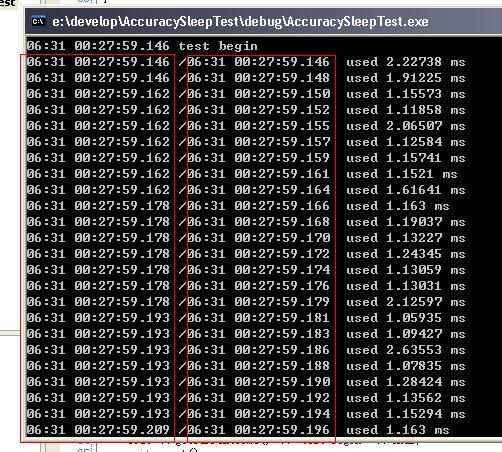受影响的操作包括Sleep、GetTickCount、_ftime等等。比如你调用Sleep(2),期待2ms之后线程自动唤醒,但是实际结果可能是15ms甚至2x ms的时候才会唤醒,对于简单应用来说影响不大,但是对于精度要求非常高的系统来说,这样的问题就是非常致命的了。
代码思路如下:
1、高精度定时器。使用Singleton模式挂起请求Sleep的线程并统一管理,后台使用Windows MultiMedia SDK的定期回调函数不断检测并回复到时的线程,超时时间与当前时间采用QueryPerformanceCounter/QueryPerformanceFrequency的高精度计时,确保整体功能可靠性。
2、精确时刻获取。由于可以获取到毫秒级别的_ftime与GetTickCount都受到Windows系统时间精度影响,最小单位只有15ms,所以需要借助QueryPerformanceCounter/QueryPerformanceFrequency进行准确计时。代码首先根据_ftime获取起始时刻的精确刻度,然后根据差量计算当前的精确时刻。
代码中的Singleton模式可以找到很多实现,因此本文不进行详述
代码(VS2005 c++编译)
1、高精度定时器
- #pragma once
- #include <Windows.h>
- #include <list>
- #include <akumaslab/system/singleton.hpp>
- namespace akumaslab{
- namespace time{
- using std::list;
- class PreciseTimerProvider
- {
- struct WaitedHandle{
- HANDLE threadHandle;
- LONGLONG elapsed;//超时时间
- } ;
- typedef list< WaitedHandle > handle_list_type;
- typedef akumaslab::system::Singleton< PreciseTimerProvider > timer_type;
- public:
- PreciseTimerProvider(void):highResolutionAvailable(false), timerID(0)
- {
- InitializeCriticalSection(&critical);
- static LARGE_INTEGER systemFrequency;
- if(0 != QueryPerformanceFrequency(&systemFrequency))
- {
- timeBeginPeriod(callbackInterval);
- highResolutionAvailable = true;
- countPerMilliSecond = systemFrequency.QuadPart/1000;
- timerID = timeSetEvent(callbackInterval, 0, &PreciseTimerProvider::TimerFunc, NULL, TIME_PERIODIC);
- }
- }
- //挂起当前线程
- //@milliSecond:超时时间,单位:毫秒
- bool suspendCurrentThread(int milliSecond)
- {
- if(milliSecond <= 0)return false;
- if (!highResolutionAvailable)return false;
- HANDLE currentThreadHandle = GetCurrentThread();
- HANDLE currentProcessHandle = GetCurrentProcess();
- HANDLE realThreadHandle(0);
- DuplicateHandle(currentProcessHandle, currentThreadHandle, currentProcessHandle, &realThreadHandle, 0, FALSE, DUPLICATE_SAME_ACCESS);
- WaitedHandle item;
- item.threadHandle = realThreadHandle;
- LARGE_INTEGER now;
- QueryPerformanceCounter(&now);
- now.QuadPart += milliSecond * countPerMilliSecond;
- item.elapsed = now.QuadPart;
- EnterCriticalSection(&critical);
- waitList.push_back(item);
- LeaveCriticalSection(&critical);
- //挂起线程
- SuspendThread(realThreadHandle);
- CloseHandle(realThreadHandle);
- return true;
- }
- //恢复超时线程
- void resumeTimeoutThread()
- {
- if (!highResolutionAvailable)return;
- LARGE_INTEGER now;
- QueryPerformanceCounter(&now);
- EnterCriticalSection(&critical);
- for (handle_list_type::iterator ir = waitList.begin(); ir != waitList.end(); )
- {
- WaitedHandle& waited = *ir;
- if (now.QuadPart >= waited.elapsed)
- {
- ResumeThread(waited.threadHandle);
- ir = waitList.erase(ir);
- continue;
- }
- ir++;
- }
- LeaveCriticalSection(&critical);
- }
- ~PreciseTimerProvider(){
- if (0 != timerID)
- {
- timeKillEvent(timerID);
- timerID = 0;
- timeEndPeriod(callbackInterval);
- }
- DeleteCriticalSection(&critical);
- }
- private:
- static void CALLBACK TimerFunc(UINT uID, UINT uMsg, DWORD dwUser, DWORD dw1, DWORD dw2)
- {
- static bool initialed = false;
- if (!initialed)
- {
- if (initialWorkThread())
- {
- initialed = true;
- }
- else{
- return;
- }
- }
- timer_type::getRef().resumeTimeoutThread();
- }
- //调整定时器工作线程优先级
- static bool initialWorkThread()
- {
- HANDLE realProcessHandle = OpenProcess(PROCESS_ALL_ACCESS, FALSE, _getpid());
- if (NULL == realProcessHandle)
- {
- return false;
- }
- if (0 == SetPriorityClass(realProcessHandle, REALTIME_PRIORITY_CLASS))
- {
- CloseHandle(realProcessHandle);
- return false;
- }
- HANDLE currentThreadHandle = GetCurrentThread();
- HANDLE currentProcessHandle = GetCurrentProcess();
- HANDLE realThreadHandle(0);
- DuplicateHandle(currentProcessHandle, currentThreadHandle, currentProcessHandle, &realThreadHandle, 0, FALSE, DUPLICATE_SAME_ACCESS);
- SetThreadPriority(realThreadHandle, THREAD_PRIORITY_TIME_CRITICAL);
- //必须关闭复制句柄
- CloseHandle(realThreadHandle);
- CloseHandle(realProcessHandle);
- return true;
- }
- private:
- const static int callbackInterval = 1;
- CRITICAL_SECTION critical;
- MMRESULT timerID;
- LONGLONG countPerMilliSecond;
- bool highResolutionAvailable;
- handle_list_type waitList;
- };
- class PreciseTimer
- {
- typedef akumaslab::system::Singleton< PreciseTimerProvider > timer_type;
- public:
- static bool wait(int milliSecond)
- {
- //static PreciseTimerProvider timer;
- return timer_type::getRef().suspendCurrentThread(milliSecond);
- }
- };
- }
- }
DEMO
- int interval = 1;
- int repeatCount = 50;
- cout << getCurrentTime() << "test begin" << endl;
- unit.reset();
- for (int i = 0; i < repeatCount; i++)
- {
- akumaslab::time::PreciseTimer::wait(interval);
- cout << getCurrentTime() << "/" << getNewTime() << " used " << unit.getPreciseElapsedTime() << " ms" << endl;
- unit.reset();
- }
2、精确时刻获取
- #pragma once
- #include <sys/timeb.h>
- #include <time.h>
- #include <Windows.h>
- #include <akumaslab/system/singleton.hpp>
- namespace akumaslab{
- namespace time{
- struct HighResolutionTime
- {
- int year;
- int month;
- int day;
- int hour;
- int min;
- int second;
- int millisecond;
- };
- class CurrentTimeProvider
- {
- public:
- CurrentTimeProvider():highResolutionAvailable(false), countPerMilliSecond(0), beginCount(0)
- {
- static LARGE_INTEGER systemFrequency;
- if(0 != QueryPerformanceFrequency(&systemFrequency))
- {
- highResolutionAvailable = true;
- countPerMilliSecond = systemFrequency.QuadPart/1000;
- _timeb tb;
- _ftime_s(&tb);
- unsigned short currentMilli = tb.millitm;
- LARGE_INTEGER now;
- QueryPerformanceCounter(&now);
- beginCount = now.QuadPart - (currentMilli*countPerMilliSecond);
- }
- };
- bool getCurrentTime(HighResolutionTime& _time)
- {
- time_t tt;
- ::time(&tt);
- tm now;
- localtime_s(&now, &tt);
- _time.year = now.tm_year + 1900;
- _time.month = now.tm_mon + 1;
- _time.day = now.tm_mday + 1;
- _time.hour = now.tm_hour;
- _time.min = now.tm_min;
- _time.second = now.tm_sec;
- if (!highResolutionAvailable)
- {
- _time.millisecond = 0;
- }
- else{
- LARGE_INTEGER qfc;
- QueryPerformanceCounter(&qfc);
- _time.millisecond = (int)((qfc.QuadPart - beginCount)/countPerMilliSecond)%1000;
- }
- return true;
- }
- private:
- bool highResolutionAvailable;
- LONGLONG countPerMilliSecond;
- LONGLONG beginCount;
- };
- class CurrentTime
- {
- public:
- static bool get(HighResolutionTime& _time)
- {
- return akumaslab::system::Singleton< CurrentTimeProvider >::getRef().getCurrentTime(_time);
- }
- };
- }
- }
DEMO:
- HighResolutionTime time;
- CurrentTime::get(time);
- const int size = 20;
- char buf[size] = {0};
- _snprintf_s(buf, size, size, "%02d:%02d %02d:%02d:%02d.%03d ", time.month, time.day, time.hour, time.min, time.second, time.millisecond);
测试结果如下,下图是高精度计时器按1ms进行Sleep的结果,左侧为使用_ftime计时,右侧为使用精确时刻计时,总体来说,虽然无法达到100%可靠,但是相对原来的15ms已经有较大提升,期望Windows能够尽快提供真正的高精度时间管理技术

-
顶
- 1






















 4865
4865

 被折叠的 条评论
为什么被折叠?
被折叠的 条评论
为什么被折叠?








